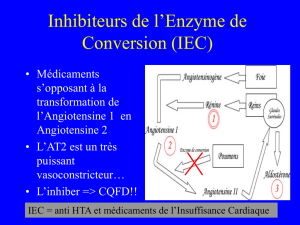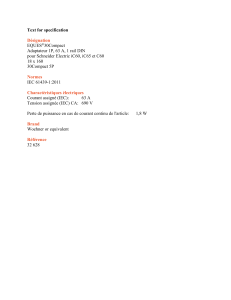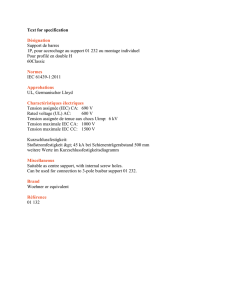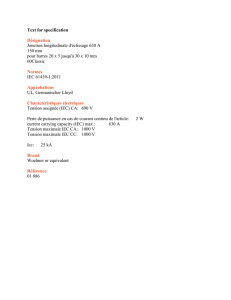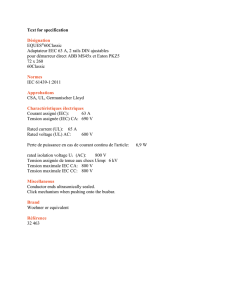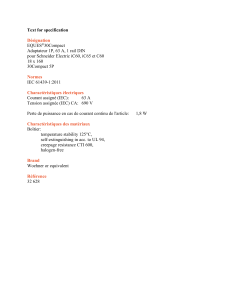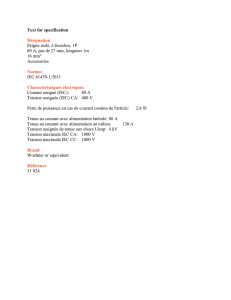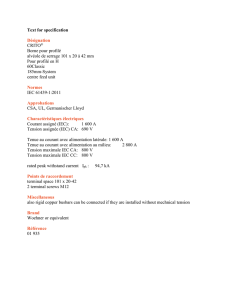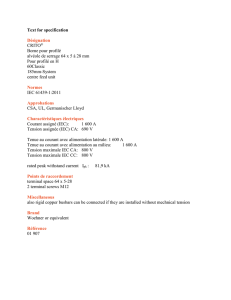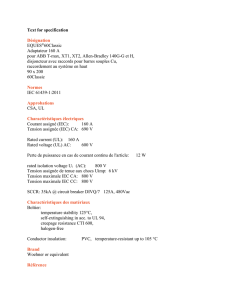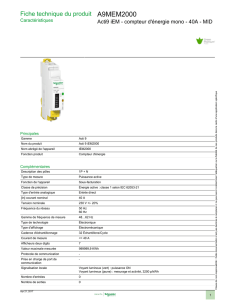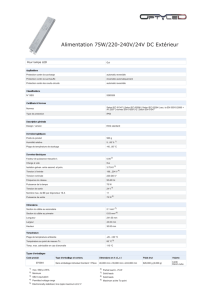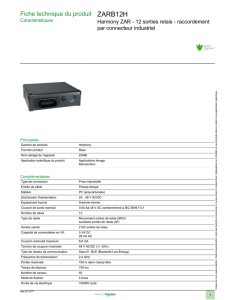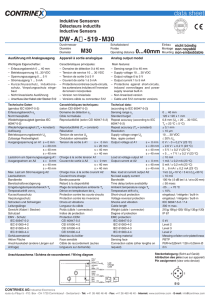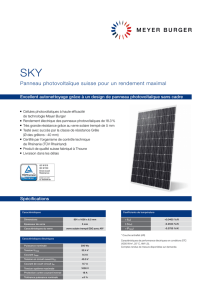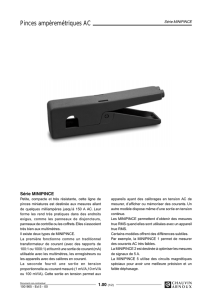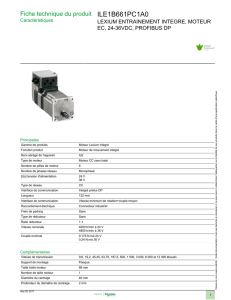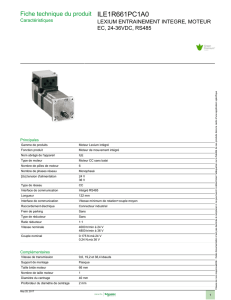norme internationale cei iec international
publicité
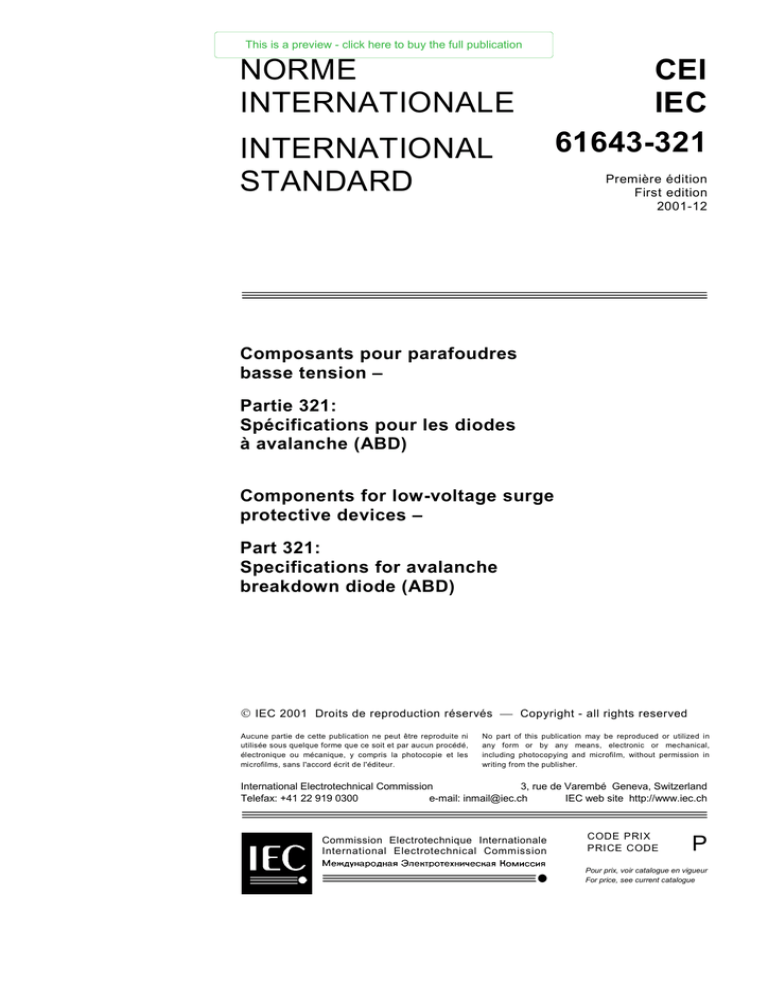
This is a preview - click here to buy the full publication NORME INTERNATIONALE INTERNATIONAL STANDARD CEI IEC 61643-321 Première édition First edition 2001-12 Composants pour parafoudres basse tension – Partie 321: Spécifications pour les diodes à avalanche (ABD) Components for low-voltage surge protective devices – Part 321: Specifications for avalanche breakdown diode (ABD) IEC 2001 Droits de reproduction réservés Copyright - all rights reserved Aucune partie de cette publication ne peut être reproduite ni utilisée sous quelque forme que ce soit et par aucun procédé, électronique ou mécanique, y compris la photocopie et les microfilms, sans l'accord écrit de l'éditeur. No part of this publication may be reproduced or utilized in any form or by any means, electronic or mechanical, including photocopying and microfilm, without permission in writing from the publisher. International Electrotechnical Commission 3, rue de Varembé Geneva, Switzerland Telefax: +41 22 919 0300 e-mail: [email protected] IEC web site http://www.iec.ch Commission Electrotechnique Internationale International Electrotechnical Commission CODE PRIX PRICE CODE P Pour prix, voir catalogue en vigueur For price, see current catalogue This is a preview - click here to buy the full publication –2– 61643-321 © CEI:2001 SOMMAIRE AVANT-PROPOS ....................................................................................................................4 1 Domaine d'application .......................................................................................................6 2 Références normatives .....................................................................................................6 3 Définitions et symboles .....................................................................................................6 4 Fonction principale et description des diodes à avalanche ............................................... 12 5 Conditions de fonctionnement ......................................................................................... 16 6 Méthodes d'essais normalisées et procédures................................................................. 16 6.1 6.2 6.3 6.4 6.5 Critère normalisé d'essai de conception ................................................................. 16 Conditions d'essais ................................................................................................ 16 Tension de blocage V C (voir figure 2)..................................................................... 18 Courant crête de choc assigné I PPM (voir figure 2) ................................................. 18 Tension maximale de fonctionnement V WM et tension maximale efficace de fonctionnement V WMeff (voir figure 3) ................................................................ 18 6.6 Courant non passant I D (voir figure 3) .................................................................... 20 6.7 Tension de claquage (d'avalanche) V BR (voir figure 4) ........................................... 20 6.8 Capacité C j ............................................................................................................ 22 6.9 Dissipation de puissance crête de choc assignée P PPM .......................................... 22 6.10 Courant de choc direct assigné I FSM (voir figure 1c) ............................................... 22 6.11 Tension directe V FS ............................................................................................... 22 7 6.12 Coefficient de température de la tension d'avalanche αV BR .................................... 24 6.13 Correction en température (voir figure 5)................................................................ 24 6.14 Résistance thermique R thJA , R thJC ou R thJL ........................................................... 24 6.15 Impédance thermique transitoire Z thJA , Z thJC ou Z thJL ............................................ 24 6.16 Dissipation de puissance moyenne assignée P MAV ................................................. 26 6.17 Tension crête de dépassement V os (voir figure 7) .................................................. 26 6.18 Durée de dépassement (voir figure 7) .................................................................... 26 6.19 Temps de réponse (voir figure 7) ........................................................................... 26 Défaillances et modes de défaillance .............................................................................. 30 7.1 7.2 7.3 7.4 Mode de défaillance dû à l'usure ............................................................................ 30 Mode de défaillance en court-circuit ....................................................................... 30 Mode de défaillance en circuit ouvert ..................................................................... 30 Fonctionnement «sûr» ........................................................................................... 30 Figure 1 – Structure, condition de polarisation et caractéristiques V-I d'une diode à avalanche unidirectionnelle ................................................................................................ 12 Figure 2 – Circuit d'essai pour la tension de blocage V C , et le courant crête de choc I PP et le courant de choc direct assigné I FSM ............................................................................... 18 Figure 3 – Circuit d'essai pour la vérification de la tension maximale de fonctionnement VWM, du courant non passant I D et de la tension maximale efficace de fonctionnement V WMeff ....... 20 Figure 4 – Circuit d'essai pour la vérification de la tension de claquage (d'avalanche) V BR ..... 20 Figure 5 – Circuit d'essai pour la vérification de la tension directe V FS ................................... 22 Figure 6 – Courbe de discontinuité de composants de diode à avalanche .............................. 26 Figure 7 – Courbe illustrant la tension de dépassement, le temps de réponse et la durée de dépassement ...................................................................................................... 28 Figure 8 – Forme d'onde de courant de choc ......................................................................... 28 This is a preview - click here to buy the full publication 61643-321 © IEC:2001 –3– CONTENTS FOREWORD ...........................................................................................................................3 1 Scope ...............................................................................................................................7 2 Normative references .......................................................................................................7 3 Definitions and symbols ....................................................................................................7 4 Basic function and description for ABDs .........................................................................13 5 Service conditions ..........................................................................................................17 6 Standard test methods and procedures...........................................................................17 6.1 6.2 6.3 6.4 6.5 Standard design test criteria ..................................................................................17 Test conditions ......................................................................................................17 Clamping voltage V C (see figure 2) ........................................................................19 Rated peak impulse current I PPM (see figure 2) .....................................................19 Maximum working voltage V WM and maximum working r.m.s. voltage V WMrms (see figure 3) .........................................................................................................19 6.6 Stand-by current I D (see figure 3) ..........................................................................21 6.7 Breakdown (avalanche) voltage V BR (see figure 4) ................................................21 6.8 Capacitance C j ......................................................................................................23 6.9 Rated peak impulse power dissipation P PPM ..........................................................23 6.10 Rated forward surge current I FSM (see figure 1c) ...................................................23 6.11 Forward voltage V FS ..............................................................................................23 7 6.12 6.13 6.14 6.15 6.16 6.17 6.18 6.19 Fault Temperature coefficient of breakdown voltage αV BR ..............................................25 Temperature derating (see figure 5) ......................................................................25 Thermal resistance R thJA or R thJC or R thJL ............................................................25 Transient thermal impedance Z thJA or Z thJC or Z thJL ..............................................25 Rated average power dissipation P MAV ..................................................................27 Peak overshoot voltage V OS (see figure 7) ............................................................27 Overshoot duration (see figure 7) ..........................................................................27 Response time (see figure 7) .................................................................................27 and failure modes ..................................................................................................31 7.1 7.2 7.3 7.4 Degradation fault mode .........................................................................................31 Short-circuit failure mode.......................................................................................31 Open-circuit failure mode ......................................................................................31 "Fail-safe" operation ..............................................................................................31 Figure 1 – Structure, bias condition and V-I characteristics for a unidirectional ABD .............13 Figure 2 – Test circuit for clamping voltage V C , peak impulse current I PP , and rated forward surge current I FSM ....................................................................................................19 Figure 3 – Test circuit for verifying maximum working voltage V WM stand-by current I D and maximum working r.m.s. voltage V WMrms ........................................................................21 Figure 4 – Test circuit for verifying breakdown (avalanche) voltage V BR ................................21 Figure 5 – Test circuit for verifying forward voltage V FS ........................................................23 Figure 6 – Derating curve for ABD components.....................................................................27 Figure 7 – Graph illustrating voltage overshoot, response time and overshoot duration.........29 Figure 8 – Impulse current waveform ....................................................................................29 This is a preview - click here to buy the full publication –4– 61643-321 © CEI:2001 COMMISSION ÉLECTROTECHNIQUE INTERNATIONALE ____________ COMPOSANTS POUR PARAFOUDRES BASSE TENSION – Partie 321: Spécifications pour les diodes à avalanche (ABD) AVANT-PROPOS 1) La CEI (Commission Électrotechnique Internationale) est une organisation mondiale de normalisation composée de l'ensemble des comités électrotechniques nationaux (Comités nationaux de la CEI). La CEI a pour objet de favoriser la coopération internationale pour toutes les questions de normalisation dans les domaines de l'électricité et de l'électronique. A cet effet, la CEI, entre autres activités, publie des Normes internationales. Leur élaboration est confiée à des comités d'études, aux travaux desquels tout Comité national intéressé par le sujet traité peut participer. Les organisations internationales, gouvernementales et non gouvernementales, en liaison avec la CEI, participent également aux travaux. La CEI collabore étroitement avec l'Organisation Internationale de Normalisation (ISO), selon des conditions fixées par accord entre les deux organisations. 2) Les décisions ou accords officiels de la CEI concernant les questions techniques représentent, dans la mesure du possible, un accord international sur les sujets étudiés, étant donné que les Comités nationaux intéressés sont représentés dans chaque comité d’études. 3) Les documents produits se présentent sous la forme de recommandations internationales. Ils sont publiés comme normes, spécifications techniques, rapports techniques ou guides et agréés comme tels par les Comités nationaux. 4) Dans le but d'encourager l'unification internationale, les Comités nationaux de la CEI s'engagent à appliquer de façon transparente, dans toute la mesure possible, les Normes internationales de la CEI dans leurs normes nationales et régionales. Toute divergence entre la norme de la CEI et la norme nationale ou régionale correspondante doit être indiquée en termes clairs dans cette dernière. 5) La CEI n’a fixé aucune procédure concernant le marquage comme indication d’approbation et sa responsabilité n’est pas engagée quand un matériel est déclaré conforme à l’une de ses normes. 6) L’attention est attirée sur le fait que certains des éléments de la présente Norme internationale peuvent faire l’objet de droits de propriété intellectuelle ou de droits analogues. La CEI ne saurait être tenue pour responsable de ne pas avoir identifié de tels droits de propriété et de ne pas avoir signalé leur existence. La Norme internationale CEI 61643-321 a été établie par le sous-comité 37B: Composants spécifiques aux parafoudres et aux dispositifs de protection contre les surtensions, du comité d'études 37 de la CEI: Parafoudres Le texte de cette norme est issu des documents suivants: FDIS Rapport de vote 37B/59/FDIS 37B/62/RVD Le rapport de vote indiqué dans le tableau ci-dessus donne toute information sur le vote ayant abouti à l'approbation de cette norme. Cette publication a été rédigée selon les Directives ISO/CEI, Partie 3. Le comité a décidé que le contenu de cette publication ne sera pas modifié avant 2005. A cette date, la publication sera • • • • reconduite; supprimée; remplacée par une édition révisée, ou amendée. This is a preview - click here to buy the full publication 61643-321 © IEC:2001 –5– INTERNATIONAL ELECTROTECHNICAL COMMISSION ____________ COMPONENTS FOR LOW-VOLTAGE SURGE PROTECTIVE DEVICES – Part 321: Specifications for avalanche breakdown diode (ABD) FOREWORD 1) The IEC (International Electrotechnical Commission) is a worldwide organization for standardization comprising all national electrotechnical committees (IEC National Committees). The object of the IEC is to promote international co-operation on all questions concerning standardization in the electrical and electronic fields. To this end and in addition to other activities, the IEC publishes International Standards. Their preparation is entrusted to technical committees; any IEC National Committee interested in the subject dealt with may participate in this preparatory work. International, governmental and non-governmental organizations liaising with the IEC also participate in this preparation. The IEC collaborates closely with the International Organization for Standardization (ISO) in accordance with conditions determined by agreement between the two organizations. 2) The formal decisions or agreements of the IEC on technical matters express, as nearly as possible, an international consensus of opinion on the relevant subjects since each technical committee has representation from all interested National Committees. 3) The documents produced have the form of recommendations for international use and are published in the form of standards, technical specifications, technical reports or guides and they are accepted by the National Committees in that sense. 4) In order to promote international unification, IEC National Committees undertake to apply IEC International Standards transparently to the maximum extent possible in their national and regional standards. Any divergence between the IEC Standard and the corresponding national or regional standard shall be clearly indicated in the latter. 5) The IEC provides no marking procedure to indicate its approval and cannot be rendered responsible for any equipment declared to be in conformity with one of its standards. 6) Attention is drawn to the possibility that some of the elements of this International Standard may be the subject of patent rights. The IEC shall not be held responsible for identifying any or all such patent rights. International Standard IEC 61643-321 has been prepared by subcommittee 37B: Specific components for surge arresters and surge protective devices, of IEC technical committee 37: Surge arresters. The text of this standard is based on the following documents: FDIS Report on voting 37B/59/FDIS 37B/62/RVD Full information on the voting for the approval of this standard can be found in the report on voting indicated in the above table. This publication has been drafted in accordance with the ISO/IEC Directives, Part 3. The committee has decided that the contents of this publication will remain unchanged until 2005. At this date, the publication will be • • • • reconfirmed; withdrawn; replaced by a revised edition, or amended. This is a preview - click here to buy the full publication –6– 61643-321 © CEI:2001 COMPOSANTS POUR PARAFOUDRES BASSE TENSION – Partie 321: Spécifications pour les diodes à avalanche (ABD) 1 Domaine d'application Cette partie de la CEI 61643 est applicable aux diodes à avalanche (ABD) qui représentent un type de composants des parafoudres (appelés ci-après SPDC) utilisés lors de la conception et la réalisation des parafoudres connectés aux réseaux basse tension de puissance, de transmission et de communication. Les spécifications d'essais de la présente norme concernent les diodes à avalanche simples à deux bornes. Toutefois, les diodes à avalanche multiples peuvent être intégrées dans un seul boîtier défini comme un ensemble de diodes. Chaque diode de cet ensemble peut être testée selon cette spécification. Cette norme contient une série de critères d'essais pour la détermination des caractéristiques électriques des diodes à avalanche. A partir des méthodes normalisées d'essais décrites ciaprès, les caractéristiques de fonctionnement et les valeurs assignées des diodes à avalanche peuvent être établies et vérifiées pour des conceptions particulières. 2 Références normatives Les documents normatifs suivants contiennent des dispositions qui, par suite de la référence qui y est faite, constituent des dispositions valables pour la présente partie de la CEI 61643. Pour les références datées, les amendements ultérieurs ou les révisions de ces publications ne s’appliquent pas. Toutefois, les parties prenantes aux accords fondés sur la présente partie de la CEI 61643 sont invitées à rechercher la possibilité d'appliquer les éditions les plus récentes des documents normatifs indiqués ci-après. Pour les références non datées, la dernière édition du document normatif en référence s’applique. Les membres de la CEI et de l'ISO possèdent le registre des Normes internationales en vigueur. CEI 60068 (toutes les parties), Essais d’environnement CEI 60364 (toutes les parties), Installations électriques des bâtiments CEI 60364-3:1993, Installations électriques des bâtiments – Partie 3: Détermination des caractéristiques générales CEI 60721 (toutes les parties), Classification des conditions d'environnement CEI 60747-2:2000, Dispositifs à semiconducteurs – Dispositifs discrets et circuits intégrés – Partie 2: Diodes de redressement CEI 60749:1996, Dispositifs à semiconducteurs – Essais mécaniques et climatiques 3 Définitions et symboles Pour les besoins de la présente norme les définitions et symboles suivants s'appliquent. NOTE Ces définitions sont applicables à un type de composants des parafoudres appelés diodes à avalanche, présentant des caractéristiques symétriques ou non en tension-courant (V-I). Elles s'appliquent aux éléments unidirectionnels (voir figure 1). Si la diode à avalanche est considérée comme bidirectionnelle, les définitions du troisième quadrant sont applicables dans les deux sens de la courbe caractéristique V-I. 3.1 diode à avalanche ABD composant destiné à limiter les tensions transitoires et à écouler les courants de foudre. C'est une diode à deux bornes qui peut comprendre de multiples éléments présentant une borne commune This is a preview - click here to buy the full publication 61643-321 © IEC:2001 –7– COMPONENTS FOR LOW-VOLTAGE SURGE PROTECTIVE DEVICES – Part 321: Specifications for avalanche breakdown diode (ABD) 1 Scope This part of IEC 61643 is applicable to avalanche breakdown diodes (ABDs) which represent one type of surge protective device component (hereinafter referred to as SPDC) used in the design and construction of surge protective devices connected to low-voltage power distribution systems, transmission, and signalling networks. Test specifications in this standard are for single ABDs consisting of two terminals. However, multiple ABDs may be assembled within a single package defined as a diode array. Each diode within the array can be tested to this specification. This standard contains a series of test criteria for determining the electrical characteristics of the ABD. From the standard test methods described herein, the performance characteristics and ratings of the ABD can be verified or established for specific packaged designs. 2 Normative references The following normative documents contain provisions which, through reference in this text, constitute provisions of this part of IEC 61643. For dated references, subsequent amendments to, or revisions of, any of these publications do not apply. However, parties to agreements based on this part of IEC 61643 are encouraged to investigate the possibility of applying the most recent editions of the normative documents indicated below. For undated references, the latest edition of the normative document referred to applies. Members of IEC and ISO maintain registers of currently valid International Standards. IEC 60068 (all parts), Environmental testing IEC 60364 (all parts), Electrical installations of buildings IEC 60364-3:1993, Electrical installations of buildings – Part 3: Assessment of general characteristics IEC 60721 (all parts), Classification of environmental conditions IEC 60747-2:2000, Semiconductor devices – Discrete devices and integrated circuits – Part 2: Rectifier diodes IEC 60749:1996, Semiconductor devices – Mechanical and climatic test methods 3 Definitions and symbols For the purpose of this part of IEC 61643, the following definitions and symbols apply. NOTE These definitions apply to one type of SPDC known as an ABD, having both symmetrical and asymmetrical voltage-current (V-I) characteristics. Such definitions are for a unidirectional element (see figure 1). If the ABD is considered bidirectional, definitions in the third quadrant will apply in both directions of the V-I characteristic curve. 3.1 avalanche breakdown diode ABD component intended to limit transient voltages and divert surge currents. This is a twoterminal diode that may be packaged with multiple elements having a common terminal
